Just over three weeks after LaLiga leaders Real Madrid were dominated by their Ligue 1 counterparts PSG at Le Parc des Princes in the first leg of their UEFA Champions League Round-of-16 tie, Los Blancos managed to turn the tide at Estadio Santiago Bernabéu to ensure that the most successful team in the history of European football’s elite competition advance to the next round over a PSG side that will now be forced to wait at least one more year before getting their hands on the Champions League trophy for what would be the very first time.
PSG could have taken more than just a one-goal lead into the second leg and probably deserved to do so based on the quality of their performance at home. However, in reality, that wasn’t the case. They only won the first leg 1-0 — a dangerous lead to take to the Bernabéu — and were punished by a clinical Karim Benzema on the night for not making more of their opportunities on the 15th of February.
Real didn’t dominate possession here, ending the game with just 47.23% of it, nor did they dominate by hitting PSG hard and fast on the counter. Real made the most of their time on the ball executing their plan well while playing in a slightly more urgent fashion than PSG played, which was perhaps somewhat influenced by the fact they were trailing the visitors coming into this game and ended up conceding first in the second leg in the first half. Real were more aggressive than their opponents without the ball, ending the game with a PPDA of 9.36 compared to PSG’s 14.93, and this aggressive pressing was vital in ensuring victory on Wednesday evening. This helped Real to take more than twice as many shots (21) than their opponents (10) while accumulating a far greater xG (3.31) than PSG (0.99) at the same time.
This tactical analysis piece breaks down three key elements of Real Madrid’s strategy and tactics that helped them to overcome PSG on Wednesday. I hope that this tactical analysis clarifies some of the key details of Ancelotti’s set-up and shines a light on how the veteran Italian coach engineered what’s sure to be a memorable victory for Los Blancos over Les Parisiens.
Calm, patient build-up and ball progression
I’ll kick off this tactical analysis by looking at Real Madrid’s performance in the early possession phases when looking to get out of their own half and into the opposition’s half. It’s well documented that PSG’s star-studded front three of Kylian Mbappé, Lionel Messi and Neymar, for all of their immense talent on the ball, offers very little without the ball. Madrid exploited this poor defensive work excellently on Wednesday, turning this weakness in PSG’s system into a key deciding factor in their 3-1 win.
As already mentioned, Real didn’t counter-attack extremely quickly and aggressively, instead preferring to build quite patiently after regaining possession in deeper areas, similar to how they operated when building regular attacks on Wednesday.
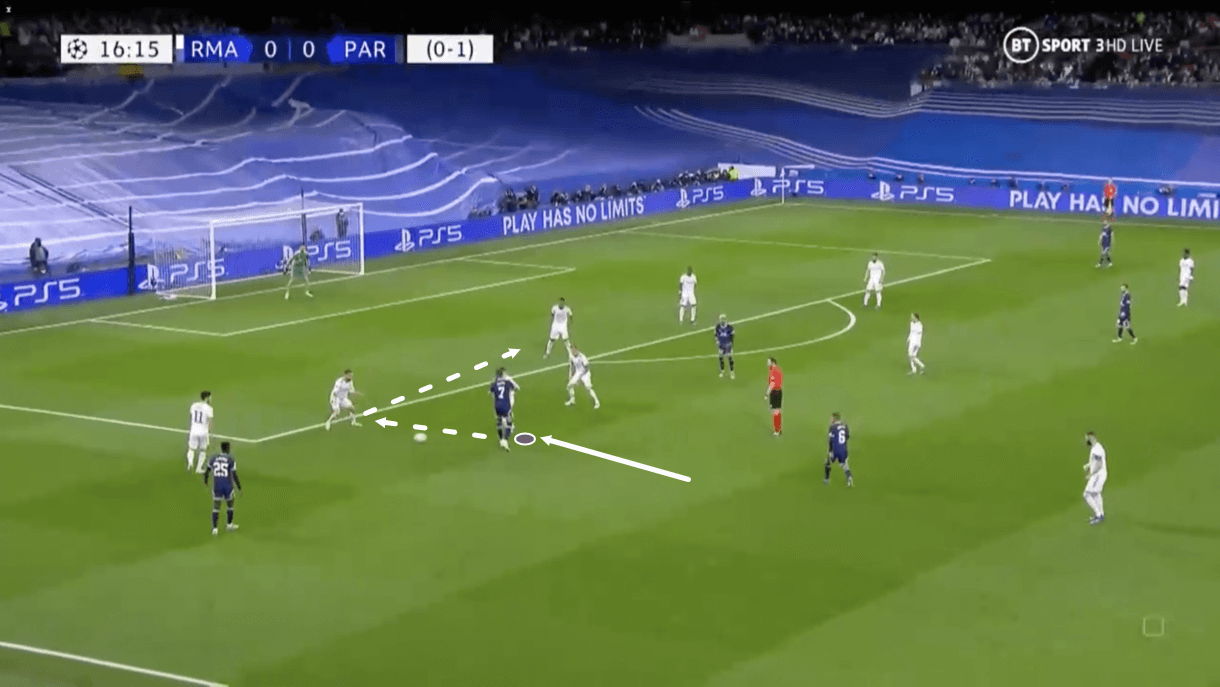
Take figure 1, for example. Here, Real Madrid have just regained possession on the edge of their box from Mbappé, putting a stop to a potentially dangerous attack led by one of world football’s most threatening dribblers and allowing Real to start thinking about an attack of their own. In this situation and situations like this one on Wednesday, Real made an effort to bide their time, not rush forward and instead play a few passes to calm play down before looking to go forward, aiming to build slowly and keep a low tempo which suited them. In this way, some calm, patient, ‘negative’ passing helped Real to create what they identified in preparation for this game as being better attacks for them.
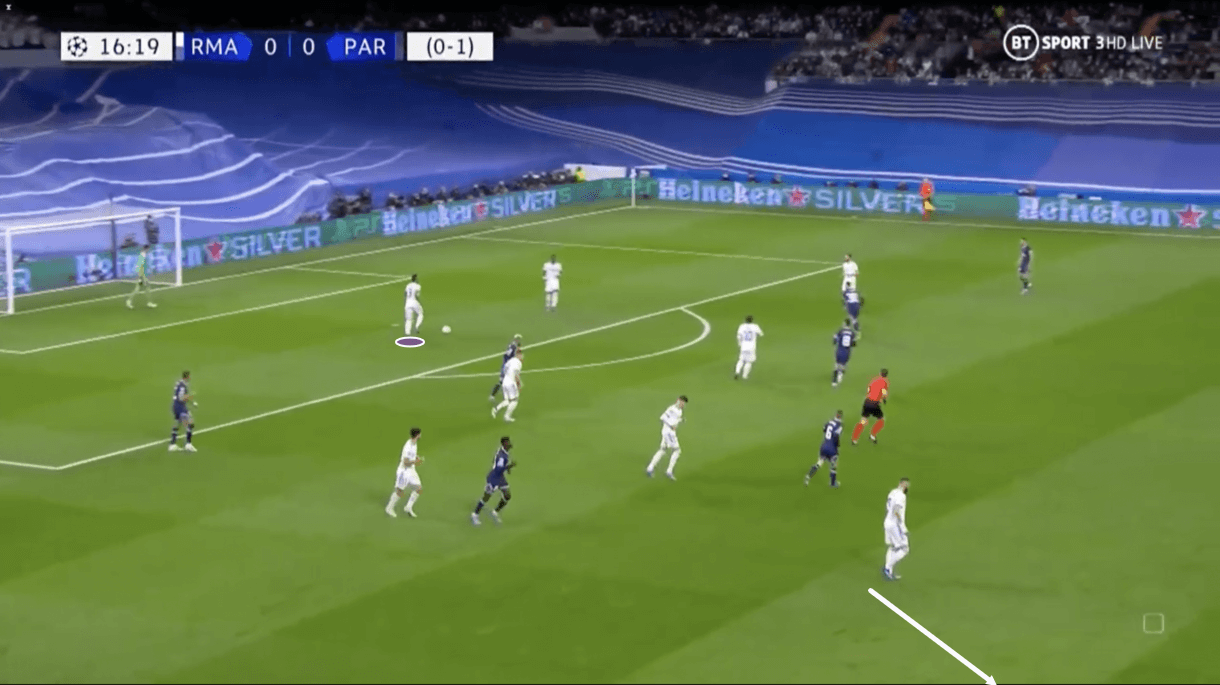
As we move on into figure 2, we see how PSG start to drop off and regroup in a structured block rather than counter-press, which was another key factor behind these Madrid tactics. Real knew they’d be afforded the time and space to calm play down after regaining possession like this because, with PSG’s shape being headed by the aforementioned front three that’s not exactly known for their defensive work, the aggressive counter-press wasn’t going to come. On this occasion in figure 2, Benzema shifted from the centre out to the right-wing to give his teammates an option out wide where he’d identified some space to attack and a long ball from the back found him. The passer had plenty of time and space to pick out this pass due to the lack of high pressure from PSG.
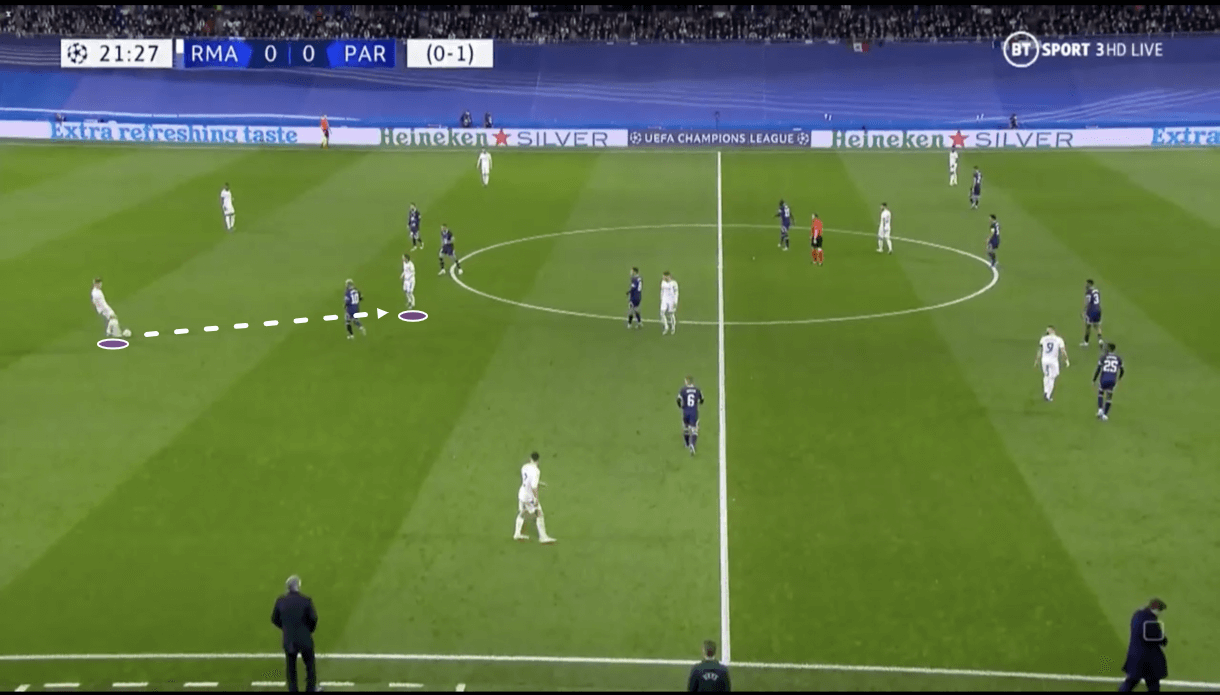
Real also exploited the lack of pressure from PSG’s front three in the progression phase, as figures 3-5 will highlight. Firstly, figure 3 shows an example of Toni Kroos, who operated as the deepest of a midfield three in this game alongside Luka Modrić and Federico Valverde, playing a forward pass into Modrić’s feet even though the Croatian is positioned right near a couple of PSG bodies in Neymar and Mbappé. Real were extremely comfortable and calm with such situations because they knew that the Paris forwards wouldn’t apply that much pressure, so as long as the pass was accurate then Modrić would be able to receive the ball, turn and drive his team upfield, which is what happened on this occasion and plenty of similar ones too.
It’s worth noting here how PSG’s marking system in midfield is set up. They aimed to always have an extra man in midfield, with two of the midfielders picking up two opposition players, as we see Danilo Pereira and Leandro Paredes doing here, while Marco Verratti was freer to pick up any other players should they drop into midfield or close down the ball carrier if they try to dribble into midfield themselves. The work of the central PSG forward, normally Neymar, was also crucial in achieving this as he was required to drop onto the deepest Madrid midfielder in this set-up to ensure the numerical advantage was retained in midfield.
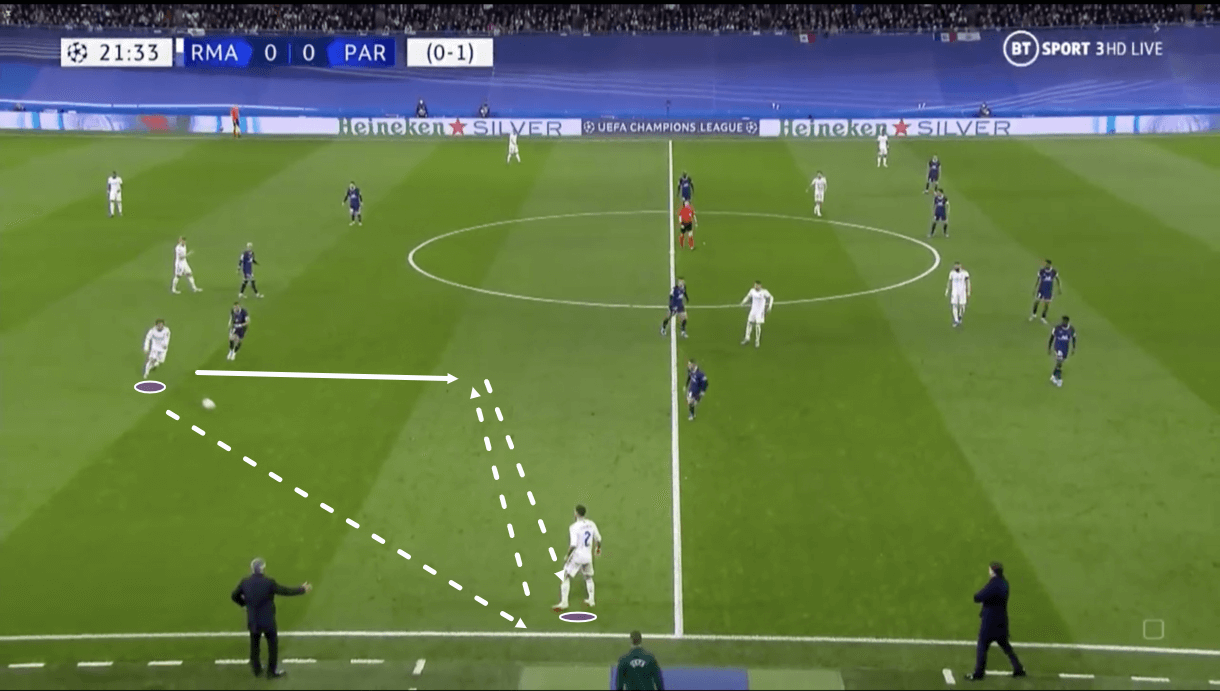
As play moves on into figure 4, we see how Modrić was able to play out of the pressure with relative ease and subsequently link up with Dani Carvajal on the right-wing via a quick one-two around Mbappé to progress into midfield before the ball was returned to Carvajal.
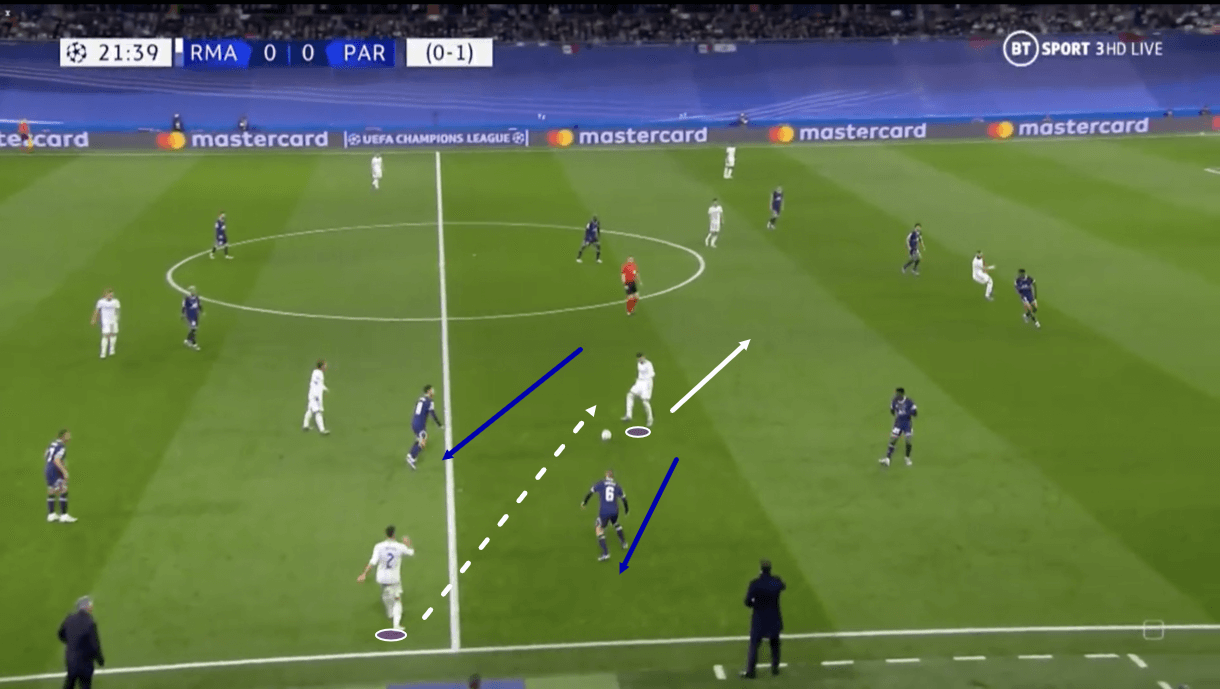
At that point, Carvajal had attracted pressure from previously free man Verratti while Paredes was dragged over by Modrić’s movement. This created a big gap between those two midfielders and Pereira, as figure 5 shows, and negated the numerical advantage as Carvajal could split the two near midfielders to get into the centre via Valverde. As play moves on from here, Valverde can turn and drive further into the opposition’s half to increase the pressure on PSG’s backline.
This passage of play shows how Madrid took advantage of PSG’s lethargic forward line in the early phases of possession by comfortably playing through them knowing the pressure they’d apply would be minimal. This paid off as Madrid were often able to break through the opposition because of this.
Wing play
The second section of this tactical analysis piece focuses on Madrid’s wing play. With Paris placing such importance on trying to ensure they had an extra body centrally, this created some chances for Real Madrid to exploit space out wide, which they did very well on Wednesday. Furthermore, exploiting space on the wings also exploited the lack of defensive work from PSG’s forwards, with the wide forwards, generally Messi and Mbappé, failing to adequately support the full-backs when Real targeted the wings. It sounds obvious to point out as everyone and their dog knows about the lack of defensive contribution from these three forwards and how it can be a problem but this was a key tactical point for Wednesday’s game and a weakness in PSG’s system that through their tactical set up and a bit of luck, Real capitalised on excellently to secure victory.
It was always going to be a gamble for Mauricio Pochettino this season in terms of whether the opposition would be punished on the counter by him and his three forwards at the other end of the pitch in transition or if his team would be punished for having just seven outfield plates in defence so much of the time and on Wednesday, unfortunately for Paris, it was far more of the latter.
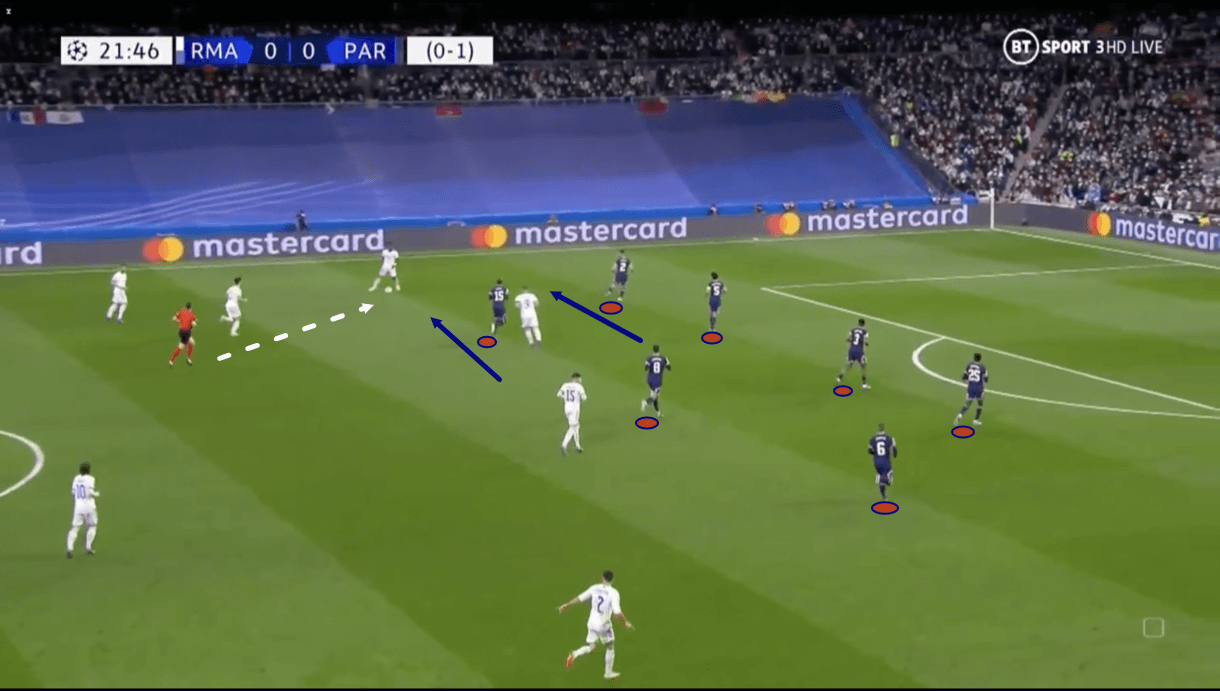
In figure 6, we see an example of Real having progressed to the final third while PSG have just seven bodies back defending their box. This was always going to be a particularly risky strategy at the Bernabéu and it’s something that Real exploited really well on the wings, as this example shows. As the ball made its way to the left-wing, PSG’s defensive shape shifted over to this side of the pitch to congest space near to the ball carrier and prevent them from playing through their defence on this side. However, this allowed a lot of space to open up on the opposite side of the pitch which Les Parisiens could exploit via a switch of play.
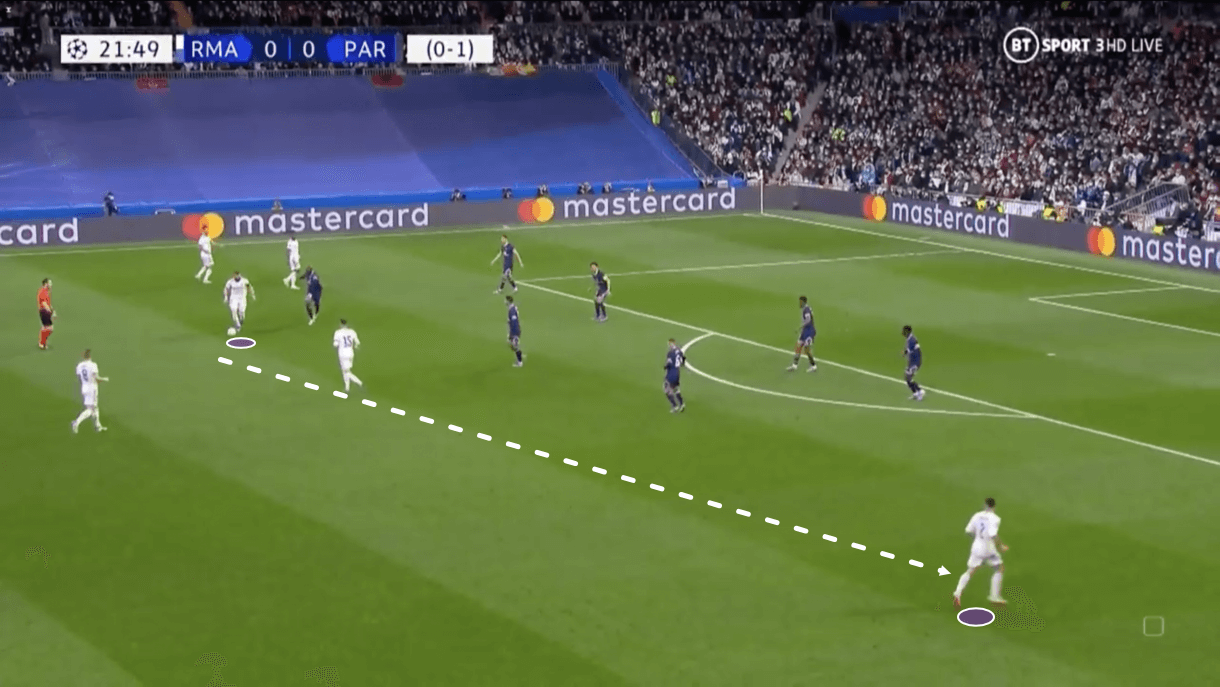
Moving on into figure 7, we see how Benzema helped his side to pull off the switch by dropping deep, which was another common theme in this game as the striker aimed to help his side generate central overloads where possible. On this occasion, Benzema’s movement helped him to receive the ball, turn and spread the play out to the opposite wing where the overlapping Carvajal was patiently waiting while providing the width on the right to receive and drive his team forward.
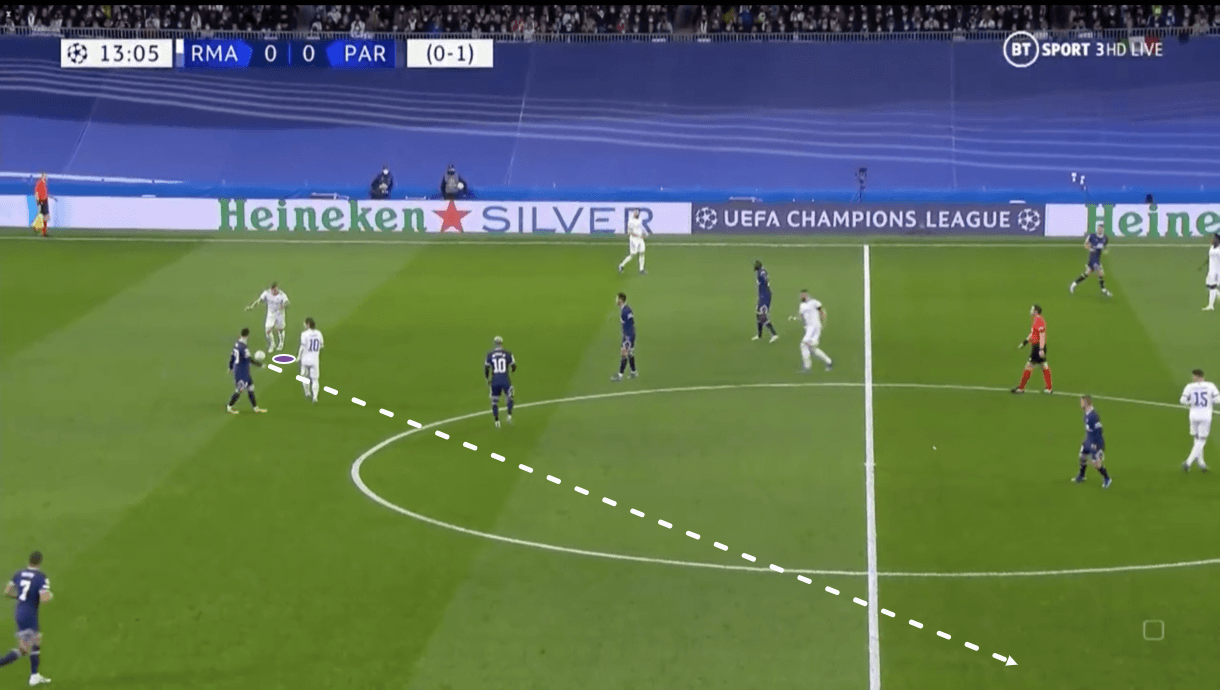
It wasn’t just common to see Real playing switches like this one from advanced positions, we also saw them do this from deeper positions, as figures 8-9 highlight. Again, this was a result of PSG’s forward line not applying any pressure to Real’s deep-lying playmaker Kroos. The German was given far too much time and space on the ball to utilise his excellent passing range and pick out runs from his teammates on the wings, particularly Carvajal on the right and Vinícius Júnior on the left, with those two players typically providing the width for their team in this one.
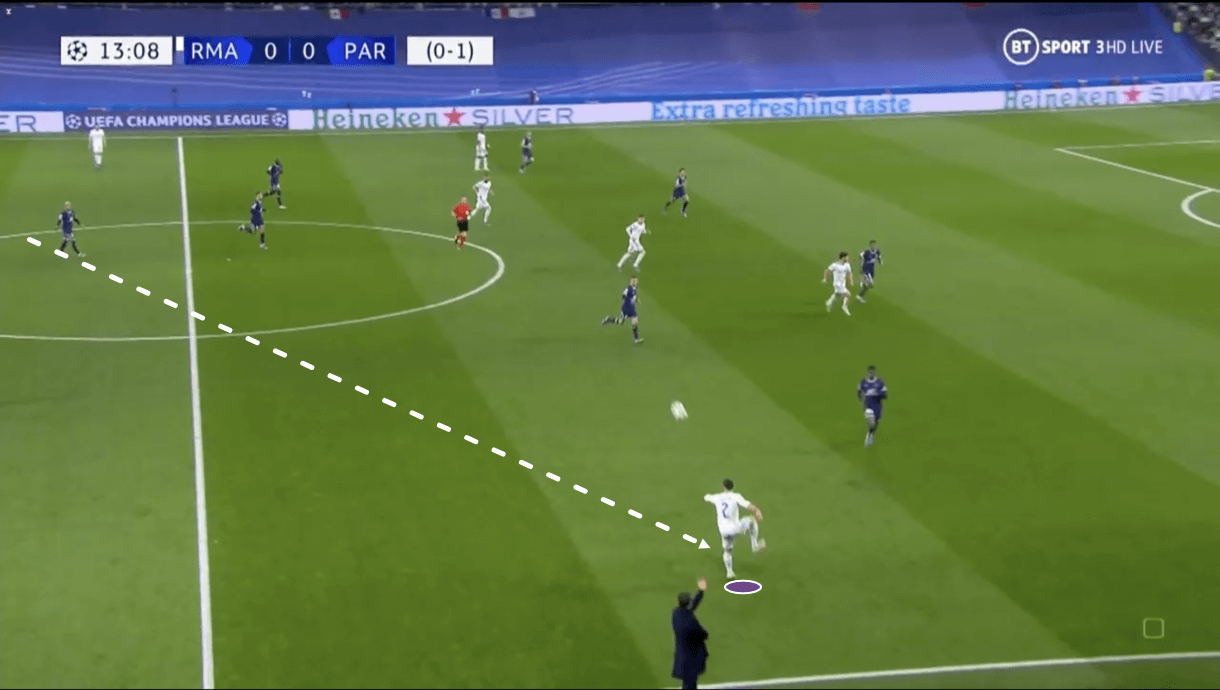
As we progress into figure 9, we see how Kroos’ long pass here found the target without any issue and set up a 1v1 for Carvajal on the right-wing, isolating him with Paris’ left-back, again highlighting the consequences of PSG’s forward line not tracking back. So, from this example, we see how PSG’s forward line 1. Not pressing and 2. Not tracking back, allowed the deep-lying playmaker time and space to launch a pinpoint long ball to the overlapping full-back and then allowed the right-back to control the ball and engage the opposition full-back in a 1v1 duel. This was particularly effective when spreading the ball out to the left as Vinícius Jr is a more skilful dribbler than Carvajal. It was common to see both Kroos and Modrić pulling off passes like this out to the wings from a comfortable, deep, central position.
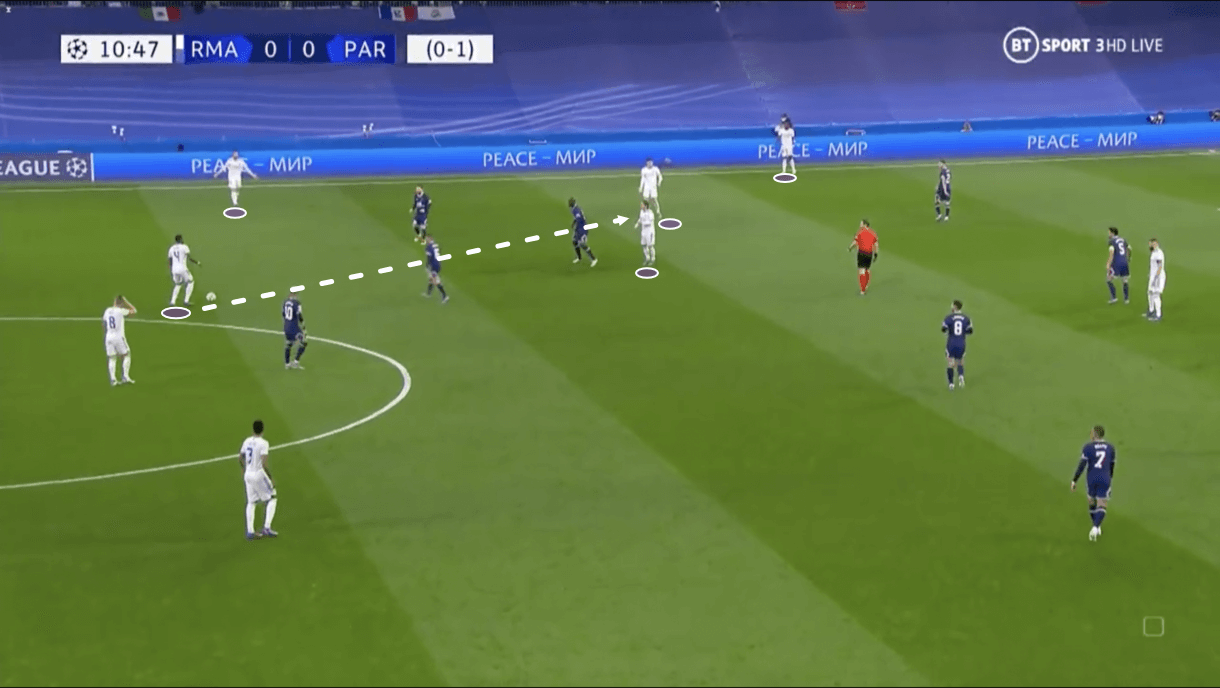
Lastly for this section, it was common to see Real Madrid overload the wings, particularly the left-wing while trying to get into the final third in this one. When doing so, it was common to see both Valverde and Modrić positioned on the same side of the pitch, as was the case in figure 10. Here, we see how both Valverde and Modrić positioned themselves behind and on either side of Messi and Pereira, with the left-back and left-winger also out there giving the ball carrier passing options. This was a particularly effective overload knowing about Messi’s lack of defensive work rate. It was common to see Pereira sticking near Messi during defensive phases to offer him some more defensive support but that job was a little too difficult to do successfully for a full 90 minutes.
Here in figure 10, we see left centre-back David Alaba send the ball between Pereira and Messi to find Valverde on the left-wing and as Valverde receives and turns between the lines, he can then carry the ball forward and create a 2v1 with his left winger versus the PSG right-back. This left-wing overload was a common sight in the ball progression phase for Real Madrid, especially early in the second half. It proved very effective at exploiting Messi defensively and helping Real to break into the final third, where chance creation was easier. This, then, was important in helping Real to create so many goalscoring opportunities in this second leg tie.
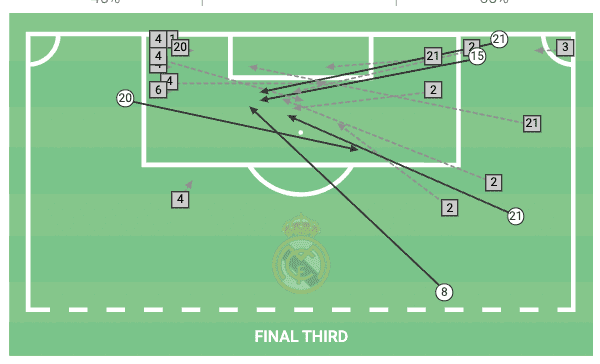
Figure 11 is a cross-map from this game. Real ended the contest having played a grand total of 21 crosses to PSG’s two, highlighting how important both wing play and the act of crossing was in their set-up on Wednesday. The switches of play and overloads discussed in this section of analysis were pivotal in helping Los Blancos to create so many crossing opportunities.
Pressing
In the final section of analysis in this tactical analysis piece, I’m going to highlight how Real Madrid’s pressing tactics were key to their victory on Wednesday. Again, as mentioned in the intro to this piece, the Spanish side ended this game with a PPDA of 9.36, which is significantly lower than PSG’s 14.93. Of course, things like the venue and aggregate score over the course of the tie will have had a big impact on that but what is for sure is that Real were aggressive in defending on the front foot on Wednesday and this helped them to create plenty of chances, even directly playing a vital role in creating both their first and third goals versus PSG.
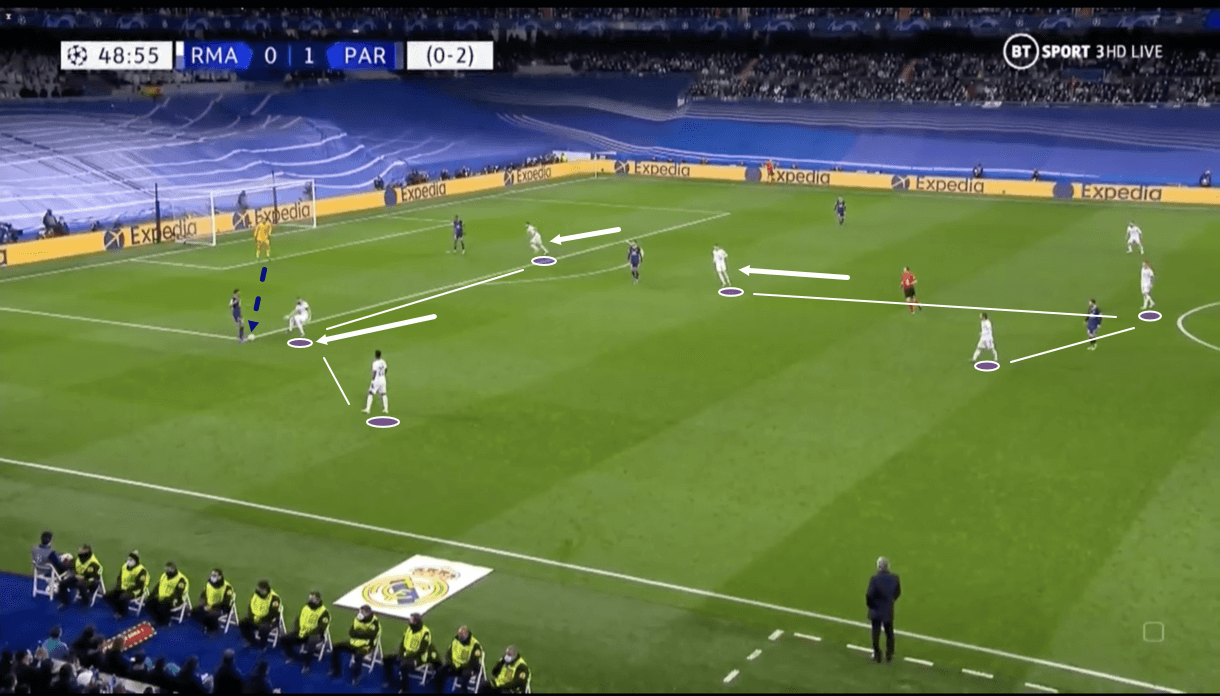
Firstly, figures 12-14 examine a passage of play in which Real’s general high press is analysed. In figure 12, we see how Real’s 4-3-3 evolved in the high block phase, with right-winger Marco Asensio making an effort to remain close to Benzema leading the line as the French striker closed down PSG’s right centre-back after receiving the ball from the goal-kick. With his movement, Asensio is able to mark the other opposition centre-back, preventing the ball carrier from using the other centre-back as an outlet here. Meanwhile, one of Real’s central midfielders, in this case Valverde has also pushed higher to mark Paris’ holding midfielder. They leave the ball-far full-back unmarked, as their intense pressure on the ball carrier means that a big switch of play is highly unlikely to come off, unlike in figure 8 when Kroos was allowed to play his long ball without any pressure, helping him to pick out a man and switch the play accurately.
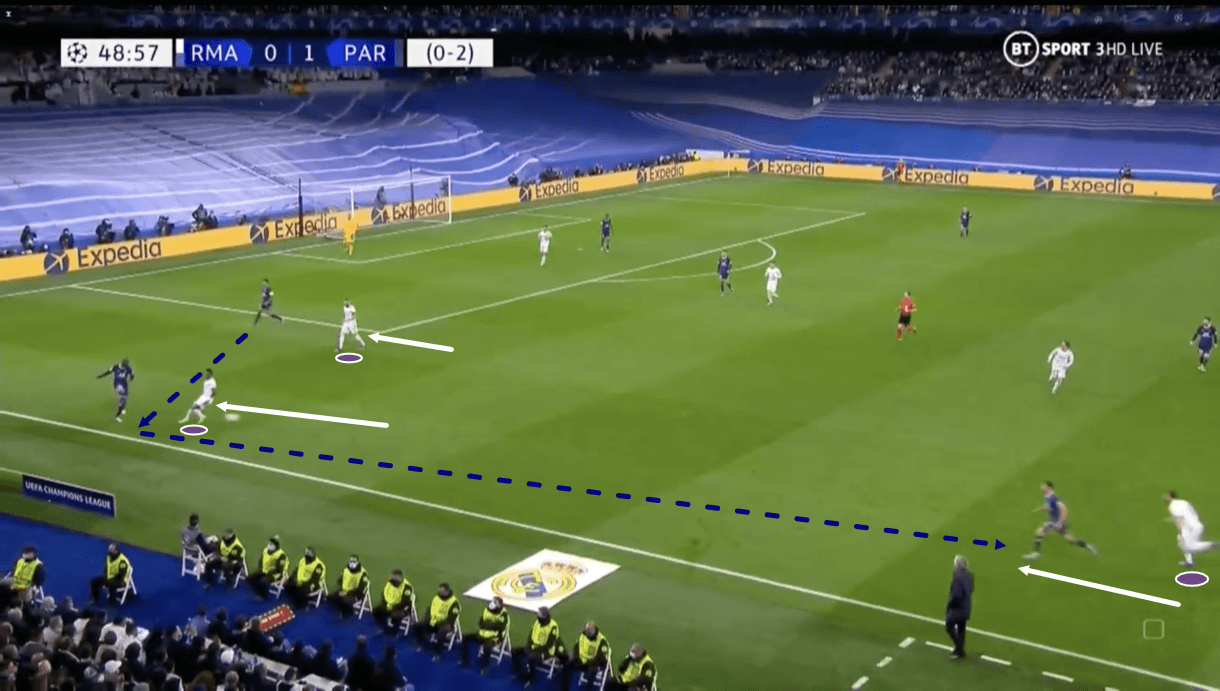
With Madrid controlling the centre in figure 12, PSG’s under-pressure right centre-back was forced out wide to the right-back as we move on into figure 13. This led to Vinícius Jr increasing the intensity of his pressing to close down the receiver at right-back — Pereira — forcing the PSG man into a rushed decision. As we can see in the image above, Pereira ended up sending the ball up the line, aiming to find Achraf Hakimi with a progressive pass to feet. However, Hakimi was being followed tightly by Real’s left-back, Nacho Fernández, who tracked the aggressive right-back as he dropped deep. As the ball arrived at Hakimi, Nacho was able to get a foot in and knock the ball out of the Moroccan’s control, which highlights the effectiveness of Nacho’s pressure.
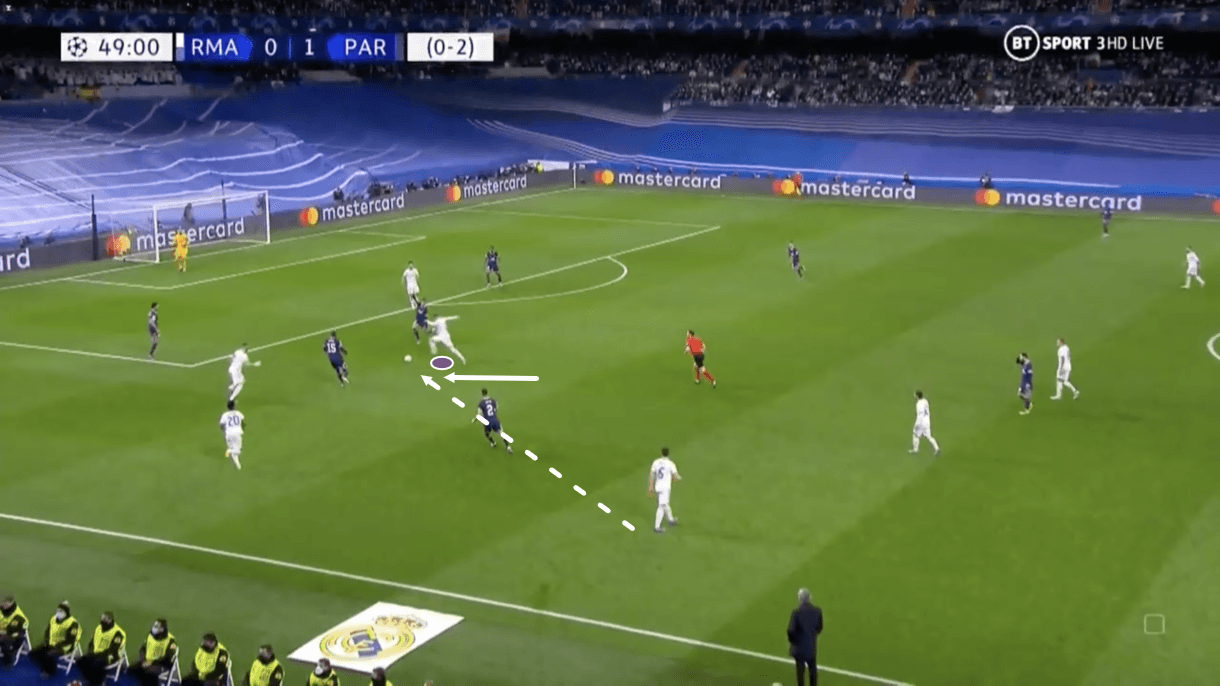
After the left-back got a foot in, he sent the ball upfield into a danger zone where his teammate could get onto the end of the ball, as seen in figure 14. This passage of play provides us with just one example of how Madrid used their high press as a creative tool versus Paris on Wednesday, with plenty of their goalscoring chances coming from their well-organised defending, as we see here.
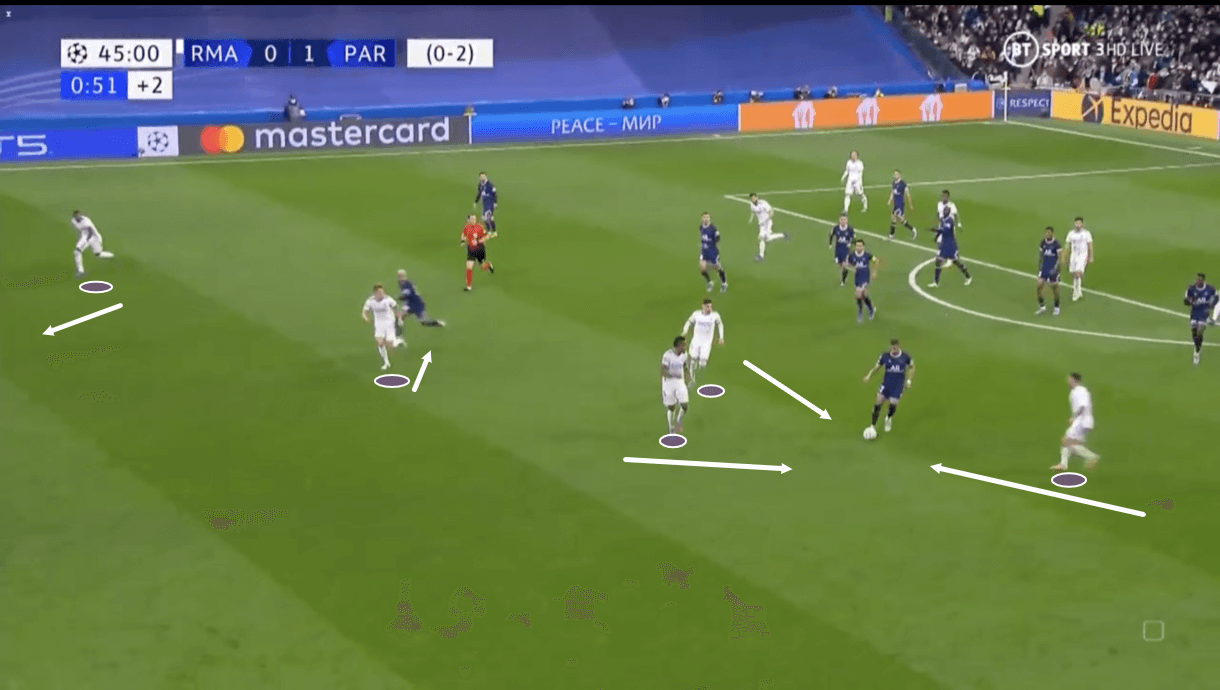
As for counter-pressing, figure 15 shows an example of one occasion where Madrid counter-pressed Mbappé to stop the PSG counter-attack early and create a renewed chance at goal for themselves in the process. Just before this image, Mbappé received the ball here just on the edge of his own third. The attacker then began dribbling forward with the ball, aiming to break past Madrid’s press and charge towards Los Blancos’ half. However, the 23-year-old quickly came under a heap of pressure from white shirts surrounding him.
This image shows an example of Madrid’s aggressive rest defence structure and how effective it was at killing PSG’s counter-attack attempts before they really got going while also manufacturing opportunities to transition to attack from an advanced position for themselves. With counter-attacks being one of PSG’s deadliest weapons, Madrid had to get this counter-press spot on to avoid getting beat and leaving acres of space for Mbappé to break away into and while there were some moments when Les Parisiens did get in behind Madrid, these defensive tactics helped them to limit such situations enough that they came away from the game with a quarter-final place.
Conclusion
To conclude this tactical analysis piece, I believe you can point to Madrid’s aggressive high press, patience in the build-up and focus on wing play as three key catalysts for their victory over Ligue 1’s leaders on Wednesday. It wasn’t easy for Madrid and with a couple of yards separating Mbappé from two more goals due to two offside decisions, things could easily have gone the other way thanks to PSG’s threat on the counter. However, as stated in the final section of this analysis, Ancelotti’s men did enough to keep Paris at bay in reality and Pochettino’s gamble didn’t pay off.





Comments